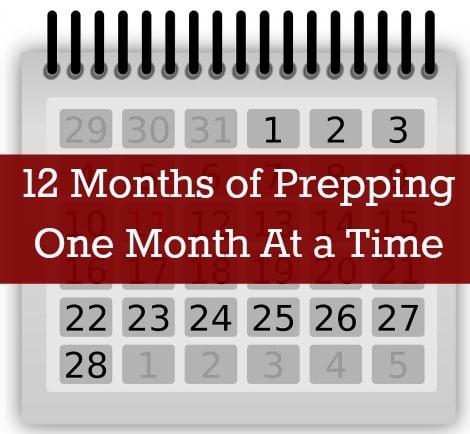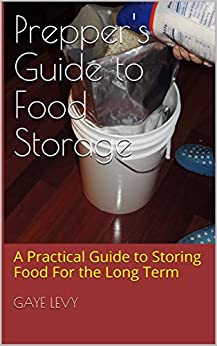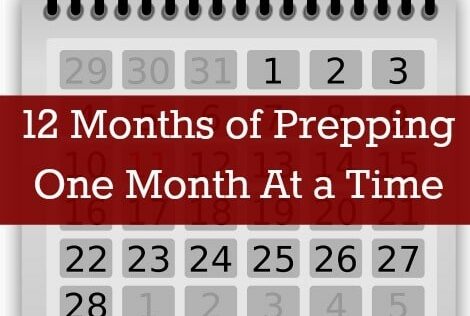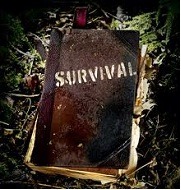This site contains affiliate links. As an Amazon Associate, I earn a commission from qualifying purchases at no extra cost to you. Full Disclosure Here.
The very first time I wrote about 12 months of prepping was back in September 2011. Needless to say, I was excited and highly motivated to share monthly checklists with the beginning prepper.
Leading up to the 12 months article, I had done a lot of reading and a ton of research. More than anything, it was overwhelming to finally learn just how much I did not know. The good news is that this was a huge blessing in disguise.
Most assuredly, I had some gaping holes in my own preps, but what better way to fill the gaps than to break things down into manageable chunks?
To provide you with the best tools and knowledge, this updated guide serves one purpose — a clear and concise breakdown that covers everything you need on your journey to preparedness, month by month.
Also Read: Preppers Guide

A Note Before Getting Started
The overwhelming popularity of the 12 Months of Prepping series took me by surprise. I was astounded. What started as a basic roadmap for a modest number of readers, expanded and grew to wherein each month, I was receiving hundreds of emails asking me questions, offering tips, and lending support for my monthly articles.
Thrilling? Yes. Humbling? You bet. Challenging? You have no idea.
Now, as we approach the end of the calendar year, I am updating the original article and posting it again with a few more tips plus links to the individual monthly posts. If you’re new to the world of emergency preparedness, I hope you find this just as useful as I would.
And for the experienced prepper? This guide will help you review your supplies, gear, bug out bag, and skills to fill in any blanks just as I have done.
The Ultimate Prepper’s Guide: Year One
On the journey towards preparedness, countless roadblocks will greet you.
Time, money, and the lack of moral support from reluctant family members all play a role in procrastinating when it comes to your efforts. And then there is fear — not only the fear that something may happen and you will not be ready but also the fear of the something itself.
For now, let’s put those fears and concerns aside and instead, focus on moving forward.
The goal is to have a manageable number of things to do in a finite amount of time, even if you have a limited cash outlay. And instead of looking at a task list 10 pages long, you’ll have a list with links to each month so that you can jump in anytime.
Month 1
Link: Getting Prepared Month 1: Supplies, Gear, and Tasks to Get You Started
SUPPLIES & GEAR:
- Water: 3 gallons per person and pet
- Hand-operated can opener and bottle opener
- Canned meat, stew, or pasta meals: 5 per person
- 2 flashlights with batteries
TASKS:
- Inventory the disaster supplies you already have on hand, including your camping gear.
- If you fill your own water containers, mark them with the date they were filled.
- Date cans of food and food containers if you have not already done so.
Month 2
Link: Getting Prepared Month 2: First Aid, Personal Hygiene and Home Safety
SUPPLIES & GEAR:
- Canned vegetables: 4 per person
- Toilet paper: 3 rolls per person
- Sanitary napkins: 2 months’ supply
- Instant drinks: Coffee, tea, powdered soft drinks
- Family-sized first aid kit
TASKS:
- Change the batteries and test your smoke detectors. Purchase and install smoke detectors if you don’t have them.
- Make an inventory of home contents for insurance purposes. Take photographs (digital are easiest) of your house and contents. Store a copy away from your home.
Month 3
Link: Getting Prepared Month 3: Special Foods, Fire Drills, and Home Safety
SUPPLIES & GEAR:
- Canned fruits: 3 cans per person
- Any foods for special dietary needs: This should be enough for 3 days
- 1-2 bags of hard candies
- A large plastic tub or bin for storage of food and other emergency supplies
TASKS:
- Conduct a home fire drill.
- Locate the gas meter and water shutoff points and attach/store a wrench or shutoff tool near them. You should also store special shutoff instructions if any.
- Establish an out-of-state contact to call in case of an emergency.
- Identify a location for storage of your plastic bin or tub.
Month 4
Link: Getting Prepared Month 4: Prescription Medicine, Cash, and Things to Keep Us Warm
SUPPLIES & GEAR:
- A minimum of a 7-day supply of critical prescription medicines
- $100 (or more) in small bills
- Pet supplies
- Infant supplies
- Extra storage containers
TASKS:
- Pack your prescription medications in a storage container with a date for annual rotation purposes.
- Stock up warm blankets, sleeping bags, socks, and other cold-weather items.
- Put any stray items in containers that are well marked.
Month 5
Link: Getting Prepared Month 5: Sanitation Supplies and Establishing a Community of Like-Minded Folks
SUPPLIES & GEAR:
- Liquid dish soap
- Plain liquid bleach
- White vinegar
- Empty spray bottles
- Liquid hand soap and hand sanitizer
- Bar of soap
- Disposable hand wipes
- Disposable latex or nitrile gloves
- Canned, ready-to-eat soup: 4 per person
- Portable AM/FM radio with batteries
TASKS:
- Make two photocopies of important papers and put one in your emergency storage and one away from your home.
- File an electronic copy of your important papers on a flash drive.
- Talk with neighbors about organizing a neighborhood preparedness group.
Month 6
Link: Getting Prepared Month 6: Fitness, Energy Bars and Face Masks
SUPPLIES & GEAR:
- Box of granola or power bars: 1 per person
- 6 rolls of paper towels
- Box of N-95 or N-100 face masks: 1 per person
TASKS:
- Check to see if stored water has expired and needs to be replaced.
- Put an extra pair of eyeglasses in the supply container.
- Find out about your workplace disaster plans and the disaster plans at your children’s schools.
Month 7
Link: Getting Prepared Month 7: Gear, Tools, and Skills to Save Lives
SUPPLIES & GEAR:
- NOAA alert weather radio
- ABC fire extinguisher
- Jug of juice: 1 per person
- Vitamins for adults and children
- A pair of pliers and/or vise grip
- 100 feet of paracord
TASKS:
- Take a first aid/CPR class.
- Show family members where and how to shut off utilities.
Month 8
Link: Getting Prepared Month 8: Adding Supplies, Tasks, and an Emergency Preparedness Kit for Your Vehicle
SUPPLIES & GEAR:
- Box of crackers or graham crackers: 1 per person
- Dry cereal or instant oatmeal: 1 weeks’ worth per person
- 1 box of large, heavy-duty garbage bags
TASKS:
- Make a small preparedness kit for your car; include food, water, blanket, small first aid kit, a list of important phone numbers.
- Secure water heaters to wall studs (if not already done).
Month 9
Link: Getting Prepared Month 9: Duct Tape and Drills
SUPPLIES & GEAR:
- Extra batteries for flashlights, radio, and hearing aids (if needed)
- Duct tape
- An additional 3 days of water to your supply per person and pet
TASKS:
- Follow up on efforts to organize a preparedness initiative for your family and your neighborhood.
- Conduct an earthquake drill at home: stop, drop and hold, then go outside. (Remember, an earthquake can happen anywhere as recent events have demonstrated.)
- Swap out stored medications with fresh versions. Review your prescription medicines and add those that are missing from your kit.
Month 10
Link: Getting Prepared Month 10: Practice Going Off-Grid
SUPPLIES & GEAR:
- Take the month off from purchases. Yay!
- Or, for extra credit, add:
- An axe
- Hatchet
- Pocket knife
- Portable (folding) shovel
TASKS:
- Practice becoming earthquake-ready by taking steps to secure appliances, shelves, cabinets, and drawers to prevent them from falling and/or opening during a tremor.
- Imagine your house with no electricity. Better yet, shut off the power for 4 to 24 hours and try to live off-grid.
Month 11
Link: Getting Prepared Month 11: Stock Up on Disposables & Build a Neighborhood Contact List
SUPPLIES & GEAR:
- Paper plates
- Napkins
- Package of eating utensils
- Paper cups
TASKS:
- Exchange work, home, and emergency contact phone numbers with neighbors for use during an emergency.
Month 12
Link: Getting Prepared Month 12: Food, Water and the Motivation to Keep Going
SUPPLIES & GEAR:
- Expand your food supply
- Purchase some comfort food or condiments
- Purchase heavy work gloves
TASKS:
- Check your water supply and rotate if necessary.
- Check over your stored food and rotate if necessary.
Month 13
Congratulations! You have successfully completed your year of preparations.
From here, you can go back to month 1 to review everything you’ve done so far. This is a good opportunity to replenish your rations and tools and also conduct drills whenever necessary to ensure that you’re at the top of your game.
Moving Forward to the Next Stage: Year 2
Once you’ve been bit by the prepping bug, your life will undoubtedly change. Trips to the grocery store will now include searching out bargains on dry goods and canned goods so that you can purchase one for now and one for later.
As we move forward to year two, you will find a greater focus on singular skills such as building a shelter, learning how to start and maintain a campfire, and cooking with the merest of basics. You’ll find a handful of these topics covered at Backdoor Survival which will equip you with everything you need.
In addition, you’ll also gain insight, tips, and strategies to help with food preservation, gardening, and the gear you will need if you are required to bug out (hopefully not) or shelter in place.
There are suggested activities, recommended purchases, viable alternatives, budget-saving strategies, and references to more reading material in each of these articles.
The Final Word
Perhaps not readily evident is that as I write and as I research, I am standing side by side with you during this journey. Like you, I continually strive to expand my knowledge and increase my survival skills. For us, our common goal is to learn to depend on ourselves not others for our basic well-being — no matter what.
I consider myself to be an ordinary citizen who, again like you, is just trying to get by in these uncertain and chaotic times. And as trite as it sounds, I hope that what I learn, what I do, and what I share will make the road to self-reliance just a bit easier for the next person.
The final word for today is this:
Emergency prepping is your journey and should be unique to your circumstances, your family, your geographical location, and your financial resources. Yes, it can be a chore, but as I have said before, it should be a chore with a happy ending.

And if you’re looking for some books on the topic, The Prepper’s Guide to Food Storage will provide you with all the details you need to create everything from an affordable food storage plan to a bug out bag, including what to buy and how to store it.
Nothing scary and nothing overwhelming — you really can do this! Now available at Amazon.











63 Responses to “1 Year of Prepping: A Month-by-Month Breakdown”
Thank you SO MUCH for compiling this. I cannot tell you how stressed I have made myself as a relative “newbie” prepper. I’m someone who wanted to get it ALL done right away, which I know is impossible, but still. I’ve done bits and pieces from all 12 months (on your list/posts) at this point, based on what my biggest concerns are. Now I can step back, breathe, and carefully go through the remaining logical steps w/o making myself crazy or wasting money.
What I have done DOES make me feel like our family is better prepared in case of any emergency. Now I can go back and fill in the gaps. Thank you. Thank you. Thank you!!!
A friend referred me to your site. It’s great. Especially the comments and that you don’t delete old ones. A comment 3 years ago is just as relevant as one posted yesterday. I especially enjoyed the discussion about machetes, which names were good etc. I going to enjoy you site.
Nice info on after EMP survival. Didn’t notice any mention of portable generators. How about putting one in your Faraday Cage with extra plugs same with chain saws. Also how well are our vehicles protected. I think if a person wanted transportation basic diesel engine vehicle is the way to go, with manual tranny. One other thing when storing water don’t put your containers on cement, use wood pallets.
Thanks for all the advice. I have been a haphazard kind of prepper, just having extras for “just in case” but you gave me the push I needed to go to the cellar and organize. The one thing that I do have that it not mentioned, is a solar oven. Basically a heavy cardboard box lined with heavy duty foil. We used it during Sandy. I kept jars of water in there all the time, hot water! I also used it for slow baking. And honey, lots of honey to mix with oatmeal and nuts. I keep everything in 5 gallon buckets so they don’t get wet. Sandy taught me a thing or two. I guess I am more of a prepper than I realized. This spring my big project is a root cellar (yurt?) dug into the side of the hillside, big enough to live in, if need be. I think I need to be an engineer to get it figured out though.
Sorry for 2nd post…I want to be sure to receive any follow up comments.
I just found your site and love the info in this post. I did notice you do not mention storing any baking supplies. Do you have recommendations on the amounts per person needed on these…sugar, flour, salt, baking powder, etc. Also I was wondering how you recommend storing things like crackers. Would they need mylar bags? I was also wondering how long the preps you have listed above are meant to be for? Thank you….Nan
12 Months of Prepping provides enough of the basics to get you by for a short period with the end result being that you will be more prepared than 90% of your neighbors. It is not designed to prepare you for XX number of days since there are way too many variables involved to do that in a short article such as this one.
I would like to suggest that you visit //www.backdoorsurvival.com/20-items-to-kick-start-your-food-storage-plan/ for more ideas.
Crackers are not typically viewed as a long term storage item unless purchased in tins. For a shorter period, you might try using mason jars with an O2 absorber. Mason jars can be sealed with the jar attachment to a FoodSaver although I have also had good luck with the jar sealing on its own with just the O2 absorber.
Hope this is helpful.
About crackers. I always have saltines and oyster crackers for use with my soups or for making peanut butter crackers, but for long term storage I buy pilot crackers in #10 cans. On sale they can be pretty reasonable, especially for a store and forget kind of food. I think I’m up to 15 of the #10 cans of pilot crackers so I have something other than rice and pasta to go with the canned meats and soups I’m storing. Variety is the spice of life. 🙂
Wow! What a great site! Lots of great info for a newbie and none of the snarky comments I’ve seen at other sites! Everyone please keep contributing – it so helps a lot and keeps me from feeling overwhelmed!
I will be very interested in receiving information.
Love the site (got my vote!). I visit here, Survival Mom, Mom with a Prep, and several others frequently. This post is probably a little long, but these are some of my experiences from beginning to prep until now. I’ve had to balance everything from budget to creative storage when I was a single mom with 1 son in a cramped 1-2 bedroom apt or house with zero storage space to repeating the process married with 2 boys. Luckily, I now have a garage to accommodate the extra storage boxes, pails, containers, etc…
I totally agree: Do NOT overwhelm yourself. Go one day (or paycheck) at a time. I do all of the food buying in our family and, I have to agree, it is extremely easy to get overwhelmed worrying over all the numbers.
Watch for sales and items of the day. Compare prices on large item purchases. The beauty of being a prepper today is that almost every store will price match to remain competitive. REI, Walmart, Target, Bass Pro, Amazon and any other stores that sells outdoor equipment are good places to watch for deals and clearance, especially during winter when they need to get rid of seasonal camping merchandise. I picked up a $100, 3 room family tent on clearance at Target for >$40 a few years back. REI in our area does a yearly clean out on leftover merchandise, returns, and slightly damaged gear. A good example: I picked up a pair of toddler kivas for my youngest for >$10 and only one of the shoes was damaged -broken tightening clasp. Easily fixed – cut the strap, tied a knot, and saved over $40.
Need a bag for a BoB on a budget or extra clothes? Shop Goodwill, Salvation Army, yard sales etc. for backpacks, flannel shirts, etc..on the cheap. They may not look pretty, but who cares as long as they function? Scratch and dent is good, except where food or other perishables are concerned.
Estate, garage, and yard sales are good places to check. Used electronics, tools, chainsaws, etc. – try before you buy. From experience, that used lawnmower may look great and sound great, but when it sputters out and dies going across not-so-high grass or on a hill.. that’s a waste of money.
One thing to think about if your budget is tight is to go in with other like-minded individuals on large quantity purchases (#5 on the list or sooner if you’re already at that point with family/friends). I can only speak about Sam’s Club membership but I’m fairly certain the membership bulk stores are similar in prices. We do have a Costco, but it’s near Dave and Busters here and with my kid(s) in tow… Id never get any shopping done. Last time I renewed, it was $40/yr for the basic membership and $100 for preferred (preferred = more in-store coupons, can shop during early morning with business customers, and other benefits). Since Sam’s is no longer cash or Discover Card only, there are more options for paying (forget VISA, they still don’t take it). Split the membership cost and make sure individual’s with the flexibility to get others that chipped in on the cost have the cards for the store. I think there’s a limit to 2 ID cards on the basic, not sure on preferred memberships.
Even if you’re not the official card carrier, you can still gain entry into the store. One card holder can bring 2 individuals in (again, basic only, not sure on preferred). If you’re single, shop together and bust up the quantities. Even when I was a single mom, I would shop at Sam’s with a friend. Neither one of us needed 50 rolls of toilet paper (nor did we have the storage space), but splitting it between 2 people made it more manageable – cost and storage wise.
Again, don’t overwhelm yourself. Whenever I go shopping for our family of 4, I always pick up something extra. If the budget is tight, I try to pick up an extra item or two under $5. At Sam’s, I’ll get a pack of water that’s on sale for less than $4. The 1/2 liter packs of bottled water go on sale frequently at Sam’s. I hate math, but I’ve figured it something like this: 1 liter = about 1 quart; 35 of the 1/2 liter bottles = 17.5 quarts; 4 quarts to a gallon = just over 4 gallons in a little more space than 4 single 1 gal jugs, they are stackable, plus they store under most beds (just ask my teenager). Check the devil of a website, aka Pinterest, for more creative storage ideas.
Just to give some background on my repackaging abilities: I have an older FoodSaver with all attachments, food grade storage buckets (given free at some places, soak in a vinegar solution for a few days to get rid of smells like icing, etc.), plus a supply of Mylar bags and oxy absorbers.
When I have the budget, time, and resources to deal with repackaging, I buy larger items at Sam’s. As of this posting, a 50lb bag of rice is less than $8, same with a 25lb bag of flour. 4lb boxes of salt are >$1. 10lb bags of sugar >$4. A 4lb bucket of ground chicken bouillon is >$10. Various boxes with 6ct -1 lb bags of pasta >$6. 25lb bag of Pinto beans are about $15. Canned meats run $10-15/per package of cans – chicken, tuna, salmon, SPAM. Again, since most of the canned packs (excluding chicken) are even numbers, split them up if you don’t have the space or budget. While $20 may seem like a lot to spend on just canned meats, splitting that 6 pack of SPAM and 10 cans of tuna with someone else means you each have 8 meats to pair with pasta, rice, etc.. without breaking the bank. In the grand scheme of things, that equals 1 week + a day of dinner meals providing you don’t have to tighten the belt ration wise. For my family of four, that breaks down to >$1.00/serving each night figuring I also have cans & jars of sauces (Alfredo, spaghetti, four cheese, etc.) stocked in the pantry.
You have to check your budgeting. Know your prices. I keep a shorthand list in my phone of prices from Sam’s on commonly bought items. The Price per Unit is coded on the price label. $8 for 10 cans of Starkist tuna is a good deal when the same cans run $1/per at the grocery store, but not so much if you can get a better price with BOGO, coupons, or the store brand for $0.50/per.
Remember: Buy what you eat and you’ll eat what you buy. You have to rotate through your stock or be faced with bad food. Some use by dates on packages are nothing more than a number to move it off the shelves or dupe the gullible into trashing it (that box of salt with a use by date of June 2015? The cardboard will disintegrate before the salt goes bad). Other items are very literal with the use by dates. Do your research.
If you’re unsure if you or your family will eat something, buy a smaller quantity first. Try it once or twice. (Not that I’m trying to persuade anyone, but SPAM is a good example of a food that more people go “ewww” at than any other I know, except maybe tofu.. Yuck!) Fried spam with scrambled eggs is an alternative to bacon if the power’s been out for awhile. SPAM in stews, gumbo, even red beans and rice tastes like the stew. It can even be eaten straight out of the can, but even I find that hard to digest. Individual cans of SPAM range from $3.50 – 5, depending on ‘flavor,’ coupons, sales, etc. (hence why $15ish dollars is a good price on a 6 pack of regular or low sodium). Get a pantry cookbook – “100 Day Pantry” is a good one and has some great tips on building up your supplies. Some of the recipes have even fooled our “I hate SPAM” visitors.
Emergencies are not the time to find out that your kids turn their noses up at tuna pasta or if you can actually cook anything from scratch with that 50lb bag of flour.
So far the closest we’ve come to an emergency situation since being married was the ice storm that ravaged the southeast last year. We were vehicle-less for 3 days due to ice, but we did have power most of the time and our home is gas heat and gas stove for cooking. There was a lot less stress and anxiety knowing that we had enough supplies to go more than a month comfortably.
Ongoing stocks: Long term supplies (honey, salt, sugar, rice, beans, etc..) and water. First aid kit (accident prone 3 yo..)
Our current projects: 3-6 month food supply.
Chuck Box for our extra kitchen supplies.
Camping box for our conglomeration of scouting gear.
Saving for LifeStraws/Berkey systems and larger wish list items.
Wow. I found this (totally by ACCIDENT) yesterday…and this is exactly what I needed to alleviate some of the stress chest pains I’ve been having over my prepping. I tend to just look at the “mess” and see a gigantic jumble that has no end. I’ve got so much going on in my head that I couldn’t even BEGIN to break it down. So I just wanted to say Thank You! Thank you for taking the time to break this down…not with lists of things that you’re trying to sell me or that you’re getting kick-backs from or come from a complete newbie stand-point. I don’t need handholding (per se)…but I definitely needed a good firm plan to examine what I’ve got and where I need to head.
And I love that these are “budget friendly” steps too. It’s difficult to remember that I don’t need to run out and buy it all today when the Fear Stalks. LOL…okay, maybe only half-LOL
I wish I could pat all your commenters on the back too. Some of their suggestions and ideas are just incredible! I find I learn just as much from the comments on some survival blogs than I do from the actual articles sometimes….and this is no exception.
Stacey – I wanted to take a moment to thank you for the kind words. It is easy to become so overwhelmed that you forget to live your life. That happens to me as well so you are in good company.
Keep on prepping – at your pace and not at the pace someone tells you is the only way 🙂